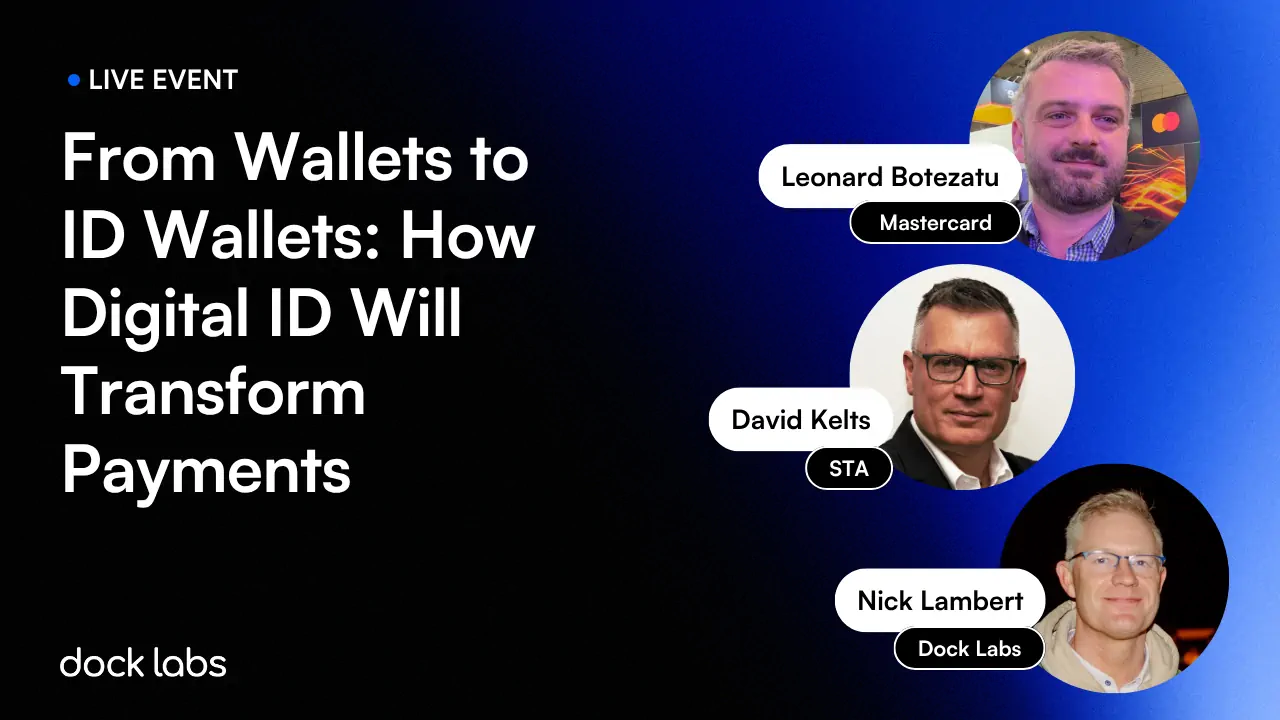As mobile driver’s licenses (mDLs) gain momentum in the U.S. and around the world, many are asking: what role will digital ID play in the future of payments?
To answer that question, we hosted a live panel with Leonard Botezatu, Director of Product & Service Design for Identity at Mastercard, and David Kelts, Co-Chair of the mDL Jumpstart Committee at the Secure Technology Alliance.
The conversation explored how digital wallets, identity standards, and mobile driver’s licenses are already transforming the way we verify identity and authorize transactions—both online and in person.
Topics included the growing adoption of mDLs, their role in fraud prevention and KYC, and how they unlock privacy-preserving user experiences. The panel also looked ahead to emerging trends like agentic AI and the convergence of digital ID and payments in a single tap.
Here are the key takeaways from the session.
mDL Adoption & Ecosystem Growth
- Current status:
- mDLs (mobile driver's licenses) are available in ~18 U.S. states, with 6–8 more expected by year-end.
- Around 5 million mDLs have been issued.
- Adoption is ~5%, representing a meaningful addressable market.
- Goal: reach ~50% state coverage by the end of 2025.
- Interoperability gaps:
- Still lacking consistent support across platforms (Apple, Google, state apps).
- Varying support for technologies like NFC, limiting seamless point-of-sale use.
- Some wallets don’t support online transactions or selective disclosure features yet.
- Secure Technology Alliance Showcase Takeaways (David):
- 14 real-world use cases demoed (bank onboarding, stadium access, age-restricted e-commerce).
- 400+ attendees highlighted excitement and fragmentation.
- Revealed challenges in interoperability between state-issued credentials and real-world verifiers.
- Industry collaboration:
- Startups to tech giants (Visa, Google, Samsung, Mastercard, Multipass) are active in the ecosystem.
- Events like the showcase foster mutual understanding between issuers, wallet providers, and relying parties.
Mastercard’s Strategic Perspective
- Why Mastercard is investing in mDLs (Leonard):
- mDLs help solve the interoperability and fragmentation issues of current ID solutions (e.g., federated login, document checks).
- Mastercard sees alignment with other global standards it already uses (e.g., ISO 20022, EMV).
- International standards like ISO 18013 enable global identity portability, much like credit cards.
- Strategic benefits:
- Universal acceptance of digital IDs will simplify identity verification in global commerce.
- Streamlines payments where identity and payment are coupled (e.g., age-restricted purchases, KYC).
- Reduces friction and improves trust for merchants and financial institutions.
User Experience & Privacy
- Benefits to end users:
- Frictionless experience by eliminating need for physical document scans.
- Selective disclosure supports privacy-by-design (e.g., prove you're 21 without showing full DOB).
- Biometric and device-based credential binding enhances both usability and security.
- Inclusion:
- Opportunity to include 1B+ people globally without IDs and the 1.4B+ unbanked.
- A remote bank onboarding demo using an mDL wallet showed seamless user experience with strong security.
Fraud Reduction & Risk Mitigation
- Fraud types addressed:
- Synthetic identity fraud: Prevented by cryptographic binding to a real person.
- Account takeover fraud: Biometrics and device-bound credentials prevent stolen credential misuse.
- Friendly fraud: Clear audit trails at point-of-sale provide verifiable proof of intent and identity.
- Security without added friction:
- mDLs offer both stronger security and reduced drop-off rates.
- Better UX means less abandonment during onboarding or age verification flows.
Reusable KYC & Business Impact
- Reusable KYC via mDLs:
- Cryptographically verifiable credentials can streamline onboarding.
- Reduced need for form-filling and document scanning.
- Potential to re-use mDLs across services and platforms with minimal friction.
- Augmenting KYC, not replacing it (David):
- mDLs can supplement existing KYC/AML flows with deterministic identity signals.
- Helps reduce fraud, operational costs, and time-to-onboard.
Payments, Commerce & Integration
- Top use cases:
- Secure remote onboarding and eKYC.
- Buy-online-pick-up-in-store for age-restricted goods.
- Tap-to-pay with ID for age/identity verification in-person.
- Stadium entry, delivery of restricted items, healthcare check-ins.
- Business value:
- Faster, more secure transactions with less manual review.
- Reduces drop-off rates and fraud-related costs.
- Clear ROI path for financial institutions and merchants.
Agentic AI & Digital ID
- Mastercard’s “Agent Pay” initiative:
- Enabling secure, tokenized AI-driven payments.
- AI agents can act on behalf of users to transact autonomously.
- mDLs (along with W3C Verifiable Credentials and JWTs) will help authenticate users in agentic commerce environments.
- Role of digital ID in AI:
- ID credentials help AI agents prove user authorization (e.g., age or identity).
- Standards like MCP (Model Context Protocol) are emerging to govern agent communication.
Standards & Interoperability
- Key standards mentioned:
- ISO 18013-5: In-person mDL data exchange.
- ISO 18013-7: Online/digital presentation.
- W3C Verifiable Credentials: Used in parallel for broader ID scenarios.
- OpenID for Verifiable Presentations: Integration between wallets, browsers, and identity frameworks.
- Global convergence:
- EU’s wallet reference architecture aligns with ISO and W3C standards.
- Enables a “write once, use globally” model for credential issuance and acceptance.
Getting Started: Advice for Organizations
- Why act now:
- The market is early but maturing rapidly, first movers can shape the ecosystem and gain trust.
- Participating now gives businesses a learning head start before mainstream rollout.
- Recommended steps (David):
- Join communities like mdlconnection.com and Secure Technology Alliance.
- Use demos and PoCs to calculate ROI, reduce fraud, and track onboarding KPIs.
- Build internal education, ROI models, and adoption roadmaps early.
- Leverage support from existing working groups (40–50 active organizations).






